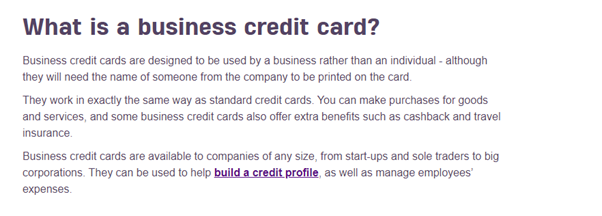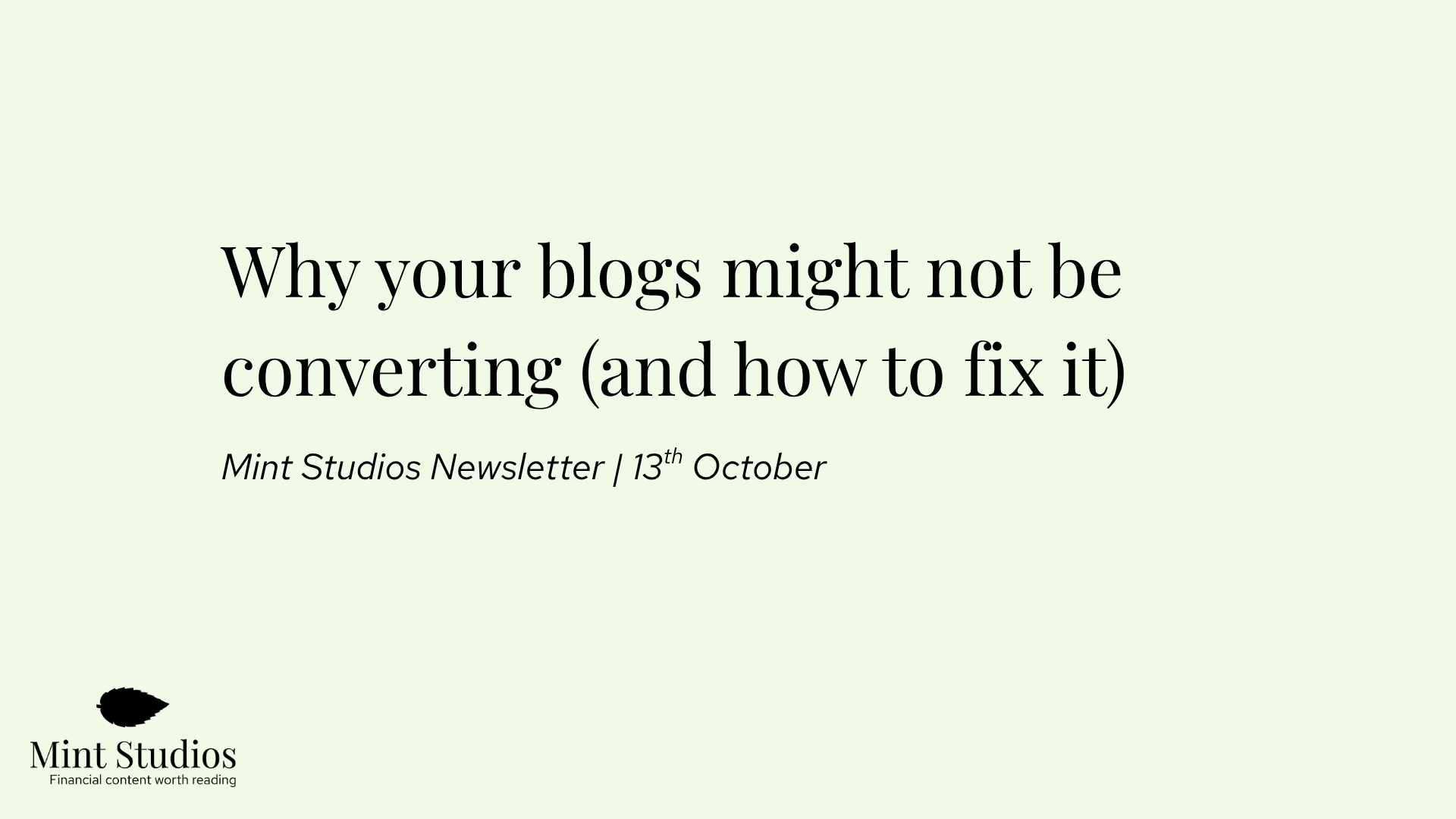If you’re an avid reader of blog posts online, then you’ve likely seen your fair share of terrible article intros.
Here’s what I mean:
“Whether you’re a director of a company or a sole trader, there could be plenty of advantages to getting a credit card for your business.”
“Managing your business’ small purchases and expenses can prove to be difficult to track and effectively account for”
“Inaccurate payroll and bookkeeping is a common issue that many businesses face.”
“With the constant changes in the technological landscape that we are experiencing today, it is important as ever to stay updated on recent technological advancements.”
If you’ve seen this before, then you’re likely nodding your head right now. For some reason, it’s popular to start blog posts with absolute sentences that make no sense, or to go all the way back and talk about “the technological landscape”.
All these introductions I posted above are for blog posts that are ranking for keywords like “xero vs quickbooks” and “best business credit card”. Does someone searching this need to be aware of the technological landscape? Unlikely.
Deep inside, we know why these intros exist. Someone has given a writer a brief on a topic they don’t know too much about (a common error). The writer probably doesn’t know what pain points the reader has, and doesn’t understand what the reader is looking for. It’s usually not the writer’s fault, but the strategist, who expects a generalist writer to write a stellar article on a topic and product they don’t know much about.
It could also be to meet a specific word count. And sure, it might get you ranking on Google — but will it get you customers?
My goal with this article is to show you what most content introductions get wrong, and then three ways to write an introduction that actually converts readers into customers.
Disclaimer:
There may be a case for writing generic intros and background introductions for thought leadership content and purely educational blog posts. But if you’re writing content that is supposed to convert (i.e. bottom of the funnel), my case is that these introductions don’t work.
Note: At Mint Studios, we help fintech companies turn their blogs into customer acquisition channels. You can learn more here.
Mistake #1: Not writing for the level of your reader
Take the example we used at the beginning of this article:
“Managing your business’ small purchases and expenses can prove to be difficult to track and effectively account for.”
If you are trying to rank for the keyword “best business credit card”, this intro completely misses the mark. With that keyword, you are targeting business owners who are comparing business cards.
Do you think they don’t know that “small purchases and expenses can prove difficult to account for”? They likely already know what a business card is. They probably already know the benefits of getting a business card. They don’t need to be sold on getting a business card — they just want to know what the best business credit cards are for their needs.
But head to the first section of articles that target these keywords, and you get:


You want to hook the reader as soon as they get on the page. If the first thing they read is some generic statement, then they’ll think this is not the place for them and leave. If you’re writing bottom of the funnel content that is supposed to make someone take action, get to the point immediately.
When you’re targeting a more technical keyword, this is even more important. If you’re writing advanced content for an advanced or technical audience, starting an article with a generic intro doesn’t make you look good. It makes you look like you don’t understand your customers, and one might argue, it’s even disrespectful. Why would they trust you if you can’t even write an article at their level of knowledge?
Here’s an introduction from a well known B2B fintech company that writes content supposedly for CFOs and finance professionals:
“New businesses rely on clear and powerful differentiators to stand out from the competition. For many consumers, nothing makes their buying decision easier than price.”
Do you think a CFO could take this company seriously after reading that first sentence? Of course “new businesses rely on differentiators to stand out”. To be fair, this article is not bottom of the funnel and covers an educational topic on pricing strategy for CFOs. But still, I would say that a generic introduction like this is unnecessary.
Mistake #2: Making the introduction too long and not adding a CTA
If you’re writing a BOFU article that is designed to convert, you want to keep the introduction short. Remember, someone who is typing an action-related keyword into Google is ready to take action. You want to give them the information they need and then make it as easy as possible to convert.
So instead of writing a 500 word introduction that doesn’t say much, you need to cut to the chase. If we were writing to entertain or it was some sort of thought leadership, then beautifully long introductions are great. But when you write to convert, you need to get to the point.
Here’s an example of a short intro I wrote for Money Dashboard:
“In a recent announcement, Yolt revealed their decision to close down their budgeting app.
If you’re a regular Yolt app user then you might be a little confused as to why this is happening, and more importantly, what the alternatives are and what you can do to make the transition to another budgeting app as smooth as possible.
We wanted to take the time to cover what we know about Yolt closing down their app, and if you’re looking for an alternative, why Money Dashboard might be the right one for you…”
Another important factor to include is to add a Call to Action right after the introduction. Sometimes a reader just wants to sign up and don’t want to bother reading. So I always add a CTA immediately after the introduction (see how I did it in this article?).
Mistake #3: Using cliches
All writers have fallen trap to using cliches, me included. When you start prioritising conciseness and are constantly reminding yourself not to waste your reader’s time, the reality of the cliche makes itself a lot more apparent. You reader is reading to buy, not to be entertained.
First cliche: beginning with generic questions.
Many SEO guides and article writing recommendations will tell you to hook your reader with a question. And sure, sometimes that can work. But more often than not, it’s simply cringey and cliche. Here’s an example:

Believe it or not, this article is written for CFOs as well.
Second cliche: generic statistics
You find these in a lot of thought leadership articles and e-commerce/SaaS content. Here’s an example from an article that ranks for the keyword “alternatives to Paypal”. Guess who wrote it? Hubspot.
“In Q1 of 2021, PayPal had 392 million active accounts worldwide. The platform facilitates payments for more than 28 million businesses and offers a fairly transparent fee structure. But what happens if you want to explore alternatives to PayPal?”
Do you think anyone searching up “alternatives to Paypal” cares about this? Probably not. But in many B2B pieces you’ll find random statistics that don’t mean anything. And not only that, if you click through you probably won’t find a real source. Statistics are only valuable if they are truly needed and well backed up with claims.
Here’s another one:

Third cliche: going way back
You’ve probably read them. Articles that talk about the technological landscape and include a huge summary on what’s currently happening in the industry.
For personal and thought leadership pieces, these intros can be great. But if you’re trying to get someone to do something, there’s no point in going so far back. It could be the most fantastic writing in the world, but the most important thing to understand is that the reader. does. not. care. They want to take action. They want to get something done. They don’t care that your mum’s dad’s dog once had to make a payment with a card.
Here is an example:

(this is an article about marketplace operations 🙄)
How to write an introduction
Ok, so how do you do it? How do you write an introduction that encourages the reader to take action?
Once again, this is my viewpoint and you are welcome to disagree. And once again, the introductions I write are mainly BOFU content that are designed to convert, not “10 ways to improve your payment UX”.
Here are my favourite ways to write an introduction:
State their pain points
The first thing a reader thinks when they land on an article is “is this the right article for me?” and “am I in the right place”? They want to know if they are in the right place to get the information they need.
That’s why the best way to help them identify themselves is to outline their pain point. I recently wrote this intro for a client:

Nice and simple. Sure, maybe a bit dry and not super exciting: but the reader knows they’re in the right place. Those that relate to the pain points of having their business and personal expenses in one place will keep reading to find out how to open a sole trader bank account.
Outline what the article will be about
If it doesn’t make sense to describe the pain points or it’s too complicated, then you can start off by describing what the article is about. I do this quite a bit for “alternatives to X” articles and comparison posts, where we’re comparing various providers.
I’ll start off with “Our goal with this article is XYZ”. This way, they know they’re in the right place if this is the kind of information they’re looking for.
We recently did this with a Money Dashboard article:

3 days later, their growth strategist told me they were getting 3x conversions (although I can’t credit the intro for doing all the heavy lifting).
Explain why the reader should listen to you
That doesn’t mean: try to hook them with a question, crazy story or cliche. It means: explain why you are an authority on this subject and why they should read your article specifically. Explain how you can add something to the conversation, and tell them something that you know about your industry or product alone.
In the example above, see how we mention that we’ve built a budgeting app ourselves? That adds legitimacy and offers a real reason why the reader should continue reading your article and not the one from another comparison site.

To summarise, here are my tips to write a good intro that converts:
- Write for the level of your reader (does your target market already know the benefits/definitions, etc? If so, don’t include them.)
- Keep your intro short and concise
- Add a clear CTA right after the intro
- Avoid cliches as much as possible
- Start the intro by:
- Stating pain points
- Outlining what you’ll talk about
- Explaining why they should listen to you
My writing is not perfect. I’ve definitely written my fair share of cliches, long intros, generic absolute statements and terrible background filler. But I’ve now learnt, and I’m hoping this article will help you get on the right track as well.
If your goal with your article is to get people to take action, keep your intros short, sweet and to the point!
Mint Studios is a full service content marketing agency that helps fintech companies turn their blogs into a customer acquisition channel. Are you publishing on your website blog but not seeing any leads? Seeing an increase in traffic but not customers? That’s where we come in.
We offer a fully done for you content marketing service that produces content that generates leads, not just traffic.











